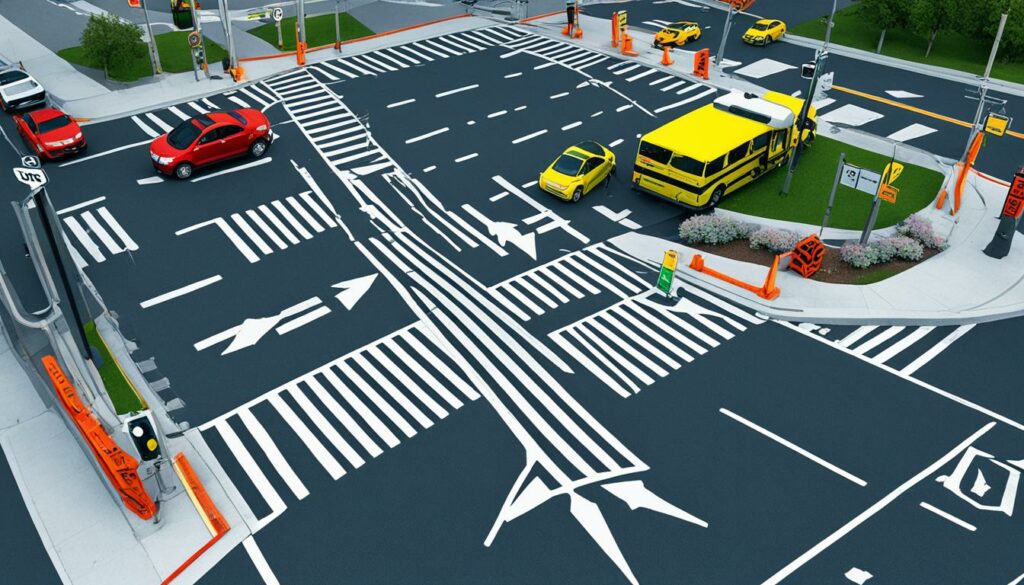Should I Drive? Safe Decision-Making Tips
Making the decision to get behind the wheel can sometimes be a complex and challenging process. Whether you are considering driving for the first time or contemplating whether it is the right choice for a specific situation, it is important to approach this decision with safety in mind.
Safe driving goes beyond just knowing how to operate a vehicle. It involves a thorough analysis of the driving benefits, pros and cons, and considerations that can impact the safety of yourself and others on the road.
In this article, we will explore various safe driving tips and decision-making strategies that can help you make informed choices when it comes to driving. From understanding the challenges at intersections to mastering the decision-making process, we will provide you with valuable insights to enhance your driving experience and keep you and others safe on the road.
Key Takeaways:
- Driving decisions require careful analysis of the benefits, pros and cons, and considerations involved.
- Understanding the challenges at intersections is crucial for safe driving.
- The decision-making process involves observation, interpretation, and action.
- Improving decision-making skills can enhance driving choices.
- Avoiding distractions and practicing defensive driving promote safer driving habits.
Challenges at Intersections

Intersections pose various challenges for drivers due to the presence of multiple traffic directions, traffic signals and signs, and the uncertainty of determining the right of way. Understanding the rules and regulations associated with intersections is essential for safe navigation on the roads of New South Wales (NSW). According to Transport for NSW’s data on road traffic casualty crashes, approximately half of all crashes in NSW occur at intersections. This alarming statistic highlights the importance of being well-informed and cautious when approaching and crossing intersections.
One of the primary challenges at intersections is determining the right of way. Different scenarios, such as stop signs, yield signs, and traffic lights, require drivers to yield or proceed based on specific rules. This can often lead to confusion and potential conflicts between vehicles. Additionally, there may be instances where multiple vehicles arrive at an intersection simultaneously, making it crucial to understand the give way rules to avoid accidents.
To ensure the safety of all road users, drivers must familiarize themselves with the road rules related to intersections. This includes knowing when to yield, when to proceed, and how to navigate roundabouts and traffic circles. By understanding and following these regulations, drivers can reduce the risk of road crashes and contribute to the overall safety of NSW roads.
The Decision-Making Process

The decision-making process plays a crucial role in ensuring safe and informed choices while driving. It involves three key factors: observation, interpretation, and action.
Observation skills are essential for gathering information about the road, traffic conditions, and potential hazards. By carefully observing the surroundings, drivers can identify potential risks and make proactive decisions to avoid accidents.
Interpretation is the next step in the decision-making process. It involves analyzing the information gathered through observation and making sense of it. By accurately interpreting the road conditions, traffic patterns, and other relevant factors, drivers can make informed choices that prioritize safety.
Finally, taking appropriate action based on the observation and interpretation is crucial. This includes making lane changes, adjusting speed, or applying the brakes in response to the road situation. By taking prompt and decisive action, drivers can navigate challenging driving scenarios confidently and safely.
The decision-making process relies on a combination of observation, interpretation, and action, enabling drivers to make the best choices while on the road.
Observation, interpretation, and action are key components of the decision-making process while driving.
| Observation | Interpretation | Action |
|---|---|---|
| Pay attention to road conditions | Assess the information gathered | React appropriately to the situation |
| Watch for traffic signs and signals | Evaluate traffic patterns | Make lane changes or adjust speed |
| Scan for potential hazards | Analyze the behavior of other drivers | Apply brakes or take evasive action |
Actionable Steps to Improve Decision Making
To enhance decision-making skills while driving, there are three actionable steps that can be taken. By focusing on these steps, drivers can develop the ability to make better choices on the road, anticipate potential hazards, and ensure a safer driving experience.
1. Anticipate and Plan Ahead
Anticipating potential scenarios and planning ahead is a crucial skill for improving decision-making on the road. By staying vigilant and actively scanning the environment, drivers can identify potential hazards in advance and plan their actions accordingly. This includes anticipating the behavior of other drivers, pedestrians, and cyclists, as well as being aware of potential road conditions and weather changes.
As part of this step, it is important to maintain a safe following distance to allow for adequate reaction time. By giving oneself enough space, drivers can avoid sudden braking or swerving and make more calculated decisions on the road.
2. Practice Defensive Driving Techniques
Defensive driving is an essential skill for improving decision-making while driving. This technique involves being proactive and taking measures to prevent accidents rather than simply reacting to them. By practicing defensive driving, drivers can effectively anticipate potential hazards and take necessary precautions.
Some defensive driving techniques include:
- Keeping a safe distance from the vehicle in front
- Using turn signals in advance to communicate intentions
- Being aware of blind spots and checking mirrors frequently
- Adapting to changing road conditions and weather
By implementing these techniques, drivers are better prepared and able to make informed decisions that prioritize safety.
3. Refine Observation Skills
Refining observation skills is another key aspect of improving decision-making while driving. By honing observation skills, drivers can gather relevant information about their surroundings, potential hazards, and the behavior of other road users.
This includes:
- Scanning the road ahead, from side to side, and checking blind spots
- Being attentive to traffic signs, signals, and road markings
- Monitoring the speed and direction of other vehicles
- Keeping an eye out for pedestrians and cyclists
By consistently practicing and refining observation skills, drivers can make more accurate judgments and safer decisions on the road.
Implementing these actionable steps to improve decision-making skills while driving can significantly enhance overall safety on the road. By anticipating and planning ahead, practicing defensive driving techniques, and refining observation skills, drivers will be better equipped to make informed choices that prioritize their safety and the safety of others.
Safe Driving Tips: Avoiding Distractions

When it comes to safe driving, it’s crucial to prioritize focus on the road and eliminate any potential distractions. By keeping your attention 100% on driving, you can reduce the risk of accidents and make safer choices on the road.
One of the most common distractions while driving is the use of mobile phones or electronic devices. It is essential to avoid using your phone while driving, as it diverts your attention away from the road and increases the likelihood of accidents. Whether it’s texting, making calls, or checking social media, these activities can wait until you reach your destination.
Another way to enhance your focus and reaction time is by slowing down while driving. By reducing your speed, you give yourself more time to react to potential hazards and make necessary maneuvers. Additionally, slowing down can help you maintain better control over your vehicle, especially in unexpected situations.
Remember, your primary responsibility is to operate your vehicle safely. Avoid any distractions that may divert your attention, particularly those involving electronic devices and mobile phones. Stay alert and give your full attention to the road.
Below is a helpful table summarizing safe driving tips and the importance of avoiding distractions:
| Safe Driving Tips | Importance |
|---|---|
| Avoid using mobile phones or electronic devices while driving. | Prevents distractions and maintains focus on the road. |
| Slowing down and reducing speed. | Gives more time to react to potential hazards and improves control over the vehicle. |
By following these safe driving tips and avoiding distractions, you can contribute to creating a safer driving environment for yourself and others on the road.
Stay Focused, Stay Safe
“Your attention should be solely on driving. Avoiding distractions is key to staying safe on the road.” – Traffic Safety Expert
Now that you understand the importance of avoiding distractions while driving, it’s time to put these tips into practice. Remember, every small action you take to maintain focus on the road can make a significant difference in ensuring your safety and the safety of others.
Defensive Driving Techniques

Defensive driving is a crucial skill that every driver should possess. By implementing defensive driving techniques, drivers can significantly reduce the risk of accidents and promote safer roads. Here are some key strategies to practice defensive driving:
Anticipate Other Drivers
One important aspect of defensive driving is anticipating the actions of other drivers on the road. By staying alert and observant, you can predict and prepare for potential hazards. Remember that not all drivers may follow the rules of the road, so practicing caution and being prepared for unexpected maneuvers can help you avoid dangerous situations.
Maintain Safe Following Distance
Another crucial defensive driving technique is maintaining a safe following distance. By keeping a safe distance between your vehicle and the one in front of you, you allow yourself enough time to react and avoid collisions. The general rule of thumb is to maintain at least a two-second gap, which increases to four seconds in adverse weather conditions or when driving at higher speeds.
Practice Caution
Being cautious and proactive is an essential aspect of defensive driving. This involves constantly scanning the road ahead, checking blind spots, and staying aware of your surroundings. Additionally, adhering to speed limits, obeying traffic signals, and using turn signals can help prevent accidents and create a safer driving environment for everyone.
Defensive driving is not just about following the rules; it’s about being aware, proactive, and taking responsibility for your actions on the road.
Remember, defensive driving is a mindset that requires constant practice and attention. By implementing these techniques, you can enhance your decision-making skills and become a safer and more responsible driver.
Take a look at the table below for a visual summary of defensive driving techniques:
| Defensive Driving Techniques | Description |
|---|---|
| Anticipate Other Drivers | Stay alert and predict potential hazards by observing the behavior of other drivers. |
| Maintain Safe Following Distance | Keep a safe distance between your vehicle and the one in front to allow for proper reaction time. |
| Practice Caution | Be cautious, proactive, and follow traffic rules to prevent accidents and create a safer driving environment. |
Impaired Driving: Making the Right Choice

Making the right choice when it comes to impaired driving is crucial for the safety of yourself and others on the road. Driving under the influence of alcohol or drugs not only puts your own life at risk but also endangers the lives of innocent people sharing the road with you.
Impaired driving can have severe consequences, both legally and personally. In many jurisdictions, there is a zero-tolerance policy for impaired driving, meaning that any amount of alcohol or drugs in your system can lead to penalties. These penalties may include fines, suspension of your driving privileges, mandatory alcohol education programs, and even imprisonment. It is essential to be aware of the DUI (Driving Under the Influence) consequences in your area to fully understand the potential outcomes of impaired driving.
Open container laws also play a significant role in preventing impaired driving. These laws prohibit driving with any open containers of alcohol in the passenger area of the vehicle. By having zero tolerance for open containers, authorities aim to discourage drivers from consuming alcohol while operating a vehicle.
Understanding and abiding by impaired driving laws is crucial, but the responsibility goes beyond mere compliance. It is essential to make responsible choices and prioritize the safety of yourself and others by never driving while impaired. There are always alternative options available, such as designating a sober driver, using rideshare services, or taking public transportation.
Remember, impaired driving is not worth the risk. By making the right choice to never get behind the wheel while impaired, you are being a responsible and caring member of your community, contributing to safer roads for everyone.
| Impaired Driving Consequences | |
|---|---|
| Legal Penalties: | Fines, suspension of driving privileges, mandatory alcohol education programs, and imprisonment. |
| Zero Tolerance: | Many jurisdictions have a zero-tolerance policy for impaired driving, meaning any amount of alcohol or drugs in your system can lead to penalties. |
| Open Container Laws: | Driving with open containers of alcohol in the passenger area is prohibited to discourage drivers from consuming alcohol while operating a vehicle. |
Road Safety Laws and Regulations
Adhering to road safety laws and regulations is crucial for driving responsibly. By following these laws, drivers can contribute to a safer driving environment for themselves and others. Let’s take a look at some key aspects of road safety that every driver should be aware of:
Traffic Rules
Understanding and obeying traffic rules is essential for maintaining order on the roads. Traffic rules cover a wide range of guidelines that help ensure the safety of all road users. These rules govern aspects such as right-of-way, lane usage, signaling, and overtaking. By following traffic rules, drivers can minimize the risk of accidents and promote a smooth flow of traffic.
Stop Sign Rules
Stop signs play a crucial role in controlling traffic at intersections. It is vital for drivers to understand the rules associated with stop signs to prevent collisions. When approaching a stop sign, drivers must come to a complete stop, yield the right-of-way to other vehicles or pedestrians, and proceed only when it is safe to do so. Failing to adhere to stop sign rules can lead to accidents and endanger the lives of everyone on the road.
Speed Limits
Speed limits are set to ensure safe driving conditions for everyone on the road. It is important for drivers to know and abide by the designated speed limits for different road types. Exceeding the speed limit not only increases the risk of accidents but also reduces the driver’s ability to react to unexpected situations. By respecting speed limits, drivers can help create a safer driving environment.
Parking Regulations
Parking regulations are in place to ensure the efficient use of parking spaces and maintain traffic flow. It is crucial for drivers to be aware of parking restrictions in different areas. This includes avoiding parking in handicapped spots without proper authorization and refraining from parking in fire hydrant zones, which can hinder emergency services. By following parking regulations, drivers can contribute to smoother traffic flow and ensure accessibility for all.
Remember, road safety laws and regulations are in place for a reason – to protect and safeguard everyone on the road. By understanding and adhering to these laws, drivers can play their part in creating a safer and more responsible driving culture.
Building a Culture of Safe Driving at Work
Creating a culture of safe driving at work is essential for promoting responsible choices and prioritizing the well-being of employees. By aligning organizational values with driving standards, setting clear goals and responsibilities, fostering accountability, and emphasizing the importance of safe driving, organizations can cultivate a safe driving culture that enhances employee engagement and reduces the risk of accidents.
Aligning Values for Safe Driving
When organizations align their values with safe driving practices, they communicate a clear expectation that safety is a top priority. By incorporating safe driving principles into company policies and procedures, organizations can ensure that employees understand the importance of responsible driving and the role it plays in representing the company. For example, a company that values integrity and respect can emphasize the importance of obeying traffic laws and treating other drivers with courtesy and consideration.
Setting Clear Goals and Responsibilities
Defining clear goals and responsibilities related to safe driving helps employees understand what is expected of them and creates a sense of accountability. Organizations should establish measurable objectives and communicate them effectively to employees. For instance, these goals could include reducing the number of accidents or near misses, increasing adherence to safety policies, or completing safe driving training programs. By setting specific targets, employees are motivated to actively participate in creating a safe driving culture.
Fostering Accountability
Accountability is crucial in building a culture of safe driving. Organizational leaders should ensure that employees understand the consequences of unsafe driving behaviors, such as increased insurance premiums, legal penalties, or other disciplinary actions. By enforcing policies consistently and providing clear feedback regarding unsafe driving practices, organizations demonstrate their commitment to maintaining a safe driving environment for all employees.
Emphasizing Employee Engagement
Engaging employees in safe driving initiatives reinforces their role as active participants in promoting a culture of safety. Organizations can encourage employee engagement by providing regular safety education and training programs, hosting interactive workshops, and implementing recognition programs to reward safe driving behaviors. By involving employees in the development of safe driving policies and procedures, organizations empower them to take ownership of their driving choices and contribute to a safer work environment.
A strong culture of safe driving at work not only protects employees but also enhances the overall reputation and success of the organization. By prioritizing accountability, values alignment, and employee engagement, organizations can create a culture that fosters responsible driving choices and ultimately contributes to safer roads for everyone.
Conclusion
Making responsible decisions and cultivating a culture of safe driving are paramount for ensuring a safer driving environment. By equipping ourselves with knowledge, skills, and the ability to make informed choices, we can navigate the road with confidence and minimize the risks associated with driving. Understanding the challenges that arise at intersections and following the correct right-of-way rules allows us to traverse these complex areas safely.
Moreover, embracing the decision-making process of observation, interpretation, and action empowers us to make responsible choices on the road. By proactively improving our decision-making skills, anticipating potential scenarios, practicing defensive driving techniques, and refining our observation abilities, we elevate our driving capabilities and reduce the likelihood of accidents.
In addition to personal growth, fostering a culture of safe driving at work plays a crucial role in promoting responsible behavior on the road. By aligning organizational values with driving standards, setting clear expectations, providing feedback, and holding employees accountable for their choices, companies can create an environment where safe driving is prioritized and valued. Adhering to road safety laws and regulations further reinforces responsible driving habits and contributes to a safer driving culture for all.
Ultimately, by making safe driving choices, practicing responsible decision-making, and embracing a driving culture focused on safety, we can ensure not only our own well-being but also the well-being of others. Let us commit to being vigilant, proactive, and responsible drivers as we continue to strive for a safer driving environment.
FAQ
Should I drive?
The decision to drive or not depends on various factors, including your driving skills, the condition of your vehicle, and your familiarity with the route. It is important to consider the pros and cons of driving and make a safe and informed decision.
What are some safe driving tips?
Some safe driving tips include avoiding distractions, maintaining focus on the road, practicing defensive driving techniques, and adhering to road safety laws and regulations.
What are the benefits of driving?
Driving offers convenience, flexibility, and freedom to travel at your own pace. It can also save time and provide independence in reaching your destination.
What are the considerations for safe driving?
When it comes to safe driving, it is important to consider factors such as road conditions, weather conditions, traffic volume, and your state of mind. Being aware of these considerations can help you make responsible choices on the road.
How do I make better decisions while driving?
To make better decisions while driving, it is crucial to enhance your observation skills, anticipate potential scenarios, practice defensive driving techniques, and refine your observation skills. These steps can help you identify and avoid potential hazards, leading to safer driving experiences.
What should I do to avoid distractions while driving?
To avoid distractions while driving, it is important to keep 100% attention on the road. This means not using mobile phones or other electronic devices during driving and slowing down to give yourself more time to react to potential hazards.
What are defensive driving techniques?
Defensive driving techniques involve being aware of other drivers’ actions, assuming that others may behave unpredictably, and maintaining a safe following distance. By practicing defensive driving techniques, you can enhance your decision-making skills and promote safer driving on the road.
Why is impaired driving dangerous?
Impaired driving, such as driving under the influence of alcohol or drugs, is dangerous because it not only puts the driver at risk but also endangers the safety of others on the road. Impaired driving can lead to accidents, severe consequences, and legal penalties.
What are some important road safety laws and regulations?
Important road safety laws and regulations include obeying traffic signals, stopping at stop signs, following speed limits, and adhering to parking regulations. It is crucial to understand and follow these laws to contribute to a safer driving environment.
How can organizations promote a culture of safe driving at work?
Organizations can promote a culture of safe driving at work by aligning organizational values with driving standards, setting clear goals and responsibilities, giving feedback, and holding individuals accountable for their choices. A safe driving culture helps promote responsible choices and ensures a safer driving environment.
How can safe driving choices be made?
Safe driving choices can be made by combining knowledge, skills, and responsible decision-making. Understanding the challenges at intersections, improving decision-making skills, and adhering to road safety laws and regulations all contribute to creating a safer driving environment.







